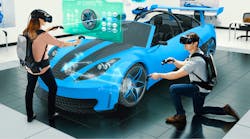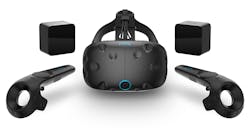Virtual reality (VR) and augmented reality (AR) are becoming more important as improved hardware is becoming readily available. The challenges are similar between AR and VR, but VR tends to require significantly higher resolution and processing power to deliver a good experience. AR solutions can often be implemented as part of the googles needed for hands-free AR applications. Smartphones usually have sufficient processing power to support this.
At the other end of the spectrum are VR platforms that typically require PC performance, often at the top end of the spectrum along with high performance graphics support. Resolutions of 1080p/eye are common, along with high frame rates.
Hewlett-Packard’s (HP) Z VR Backpack G1 Workstation and docking station (Fig. 1) targets mobile virtual reality applications. The G1 uses NVidia’s Quadro P5200 graphics subsystem with 16 Gbytes of video memory. It uses an Intel Core i7 vPro-based processor that makes remote management easier, and TPM 2.0 security hardware is included, as well. The backpack unit unsnaps from the harness and plugs into the docking station. The backpack harness also has quick release straps. The docking station supports up to two displays.
The backpack unit running Microsoft Windows 10 is paired with a head-mounted display (HMD) like the HTC Vive (Fig. 2). HP is selling the business version with the backpack. The combination addresses major VR concerns, including performance, run time, and manageability.
The backpack unit has a pair of hot swap batteries. The HP Z VR Backpack G1 Workstation is priced at $3,299. The HTC Vive business edition is available separately. It is priced at $1,200.
There are a number of advantages to using the backpack approach in addition to the lack of a tether. The batteries can be larger, providing significantly longer run times. The higher-performance processing platforms allow for better VR rendering. In addition, the backpack enables more sophisticated applications such as collaborative design visualization and virtual reality showrooms.
HP also announced the HP Mars Home Planet project (Fig. 3) in conjunction with NVIDIA, Technicolor, Fusion, Autodesk, Unreal, Launch Forth and Vive. The idea is to create a global online co-creation VR community to reinvent life on Mars.
Virtual reality applications are currently dominated by gaming applications where 3D environments are already available. Utilizing them in a VR presentation mode is a comparatively easy task. Commercial and industrial applications tend to be harder to generate, as ease of use and presentation quality take precedence over fast-moving game play.
There are other wearable PC solutions, but the HP Z VR Backpack G1 Workstation has a number of advantages such as its management oriented processing platform and dual, hot-swappable batteries. These can be used for AR or non-AR/VR applications as well. All it takes is a little imagination.





